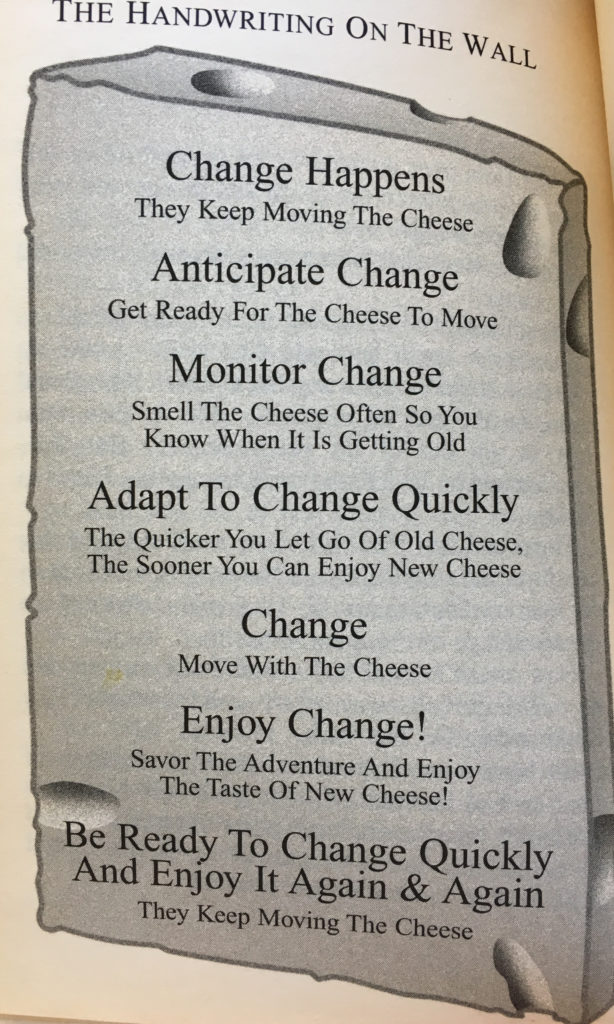SNQ: Spencer Johnson’s “Who Moved My Cheese?”
by Miles Raymer

Summary:
Spencer Johnson’s Who Moved My Cheese? is an allegorical tale about how to think about and respond to change. It tells the story of four characters who live in a large Maze and must explore the Maze to find cheese. There are two mice, Sniff and Scurry, and two littlepeople, Hem and Haw. They discover a large stash of cheese in Cheese Station C and settle into a routine of traveling there each day to fill their bellies. But over time they consume all the cheese at Station C and one day there is no cheese left when they arrive. We then observe how each character reacts to this situation, representing four basic ways that people tend to respond to change. Sniff and Scurry immediately venture out into the Maze in search of new cheese, but for Hem and Haw the situation is more complicated. Hem begins to complain and blame others for the lack of cheese, seeing himself as the victim of circumstance. Haw, in contrast, slowly adapts his attitude and learns to embrace change in search of new cheese. This simple, fun, and surprisingly profound little book is a great way to introduce people of all ages to the inevitability of change and the variety of better and worse ways we can think and behave when change arrives.
Key Concepts and Notes:
- Who Moved My Cheese? is a great book for people who don’t like change and spend a lot of time, energy, and resources trying to insulate themselves from change. I am one of these people. I identify a lot more with Hem and Haw than with Sniff and Scurry. While I am adaptable in some ways, my life is extremely routinized and designed to support self-regulation via reduction of unexpected stressors. There are substantial benefits to living in this fashion, but also major downsides. I have a hard time letting go of my routines and just “going with the flow,” and the worst parts of my personality usually surface when unexpected events get in the way of my plans. This book was a nice nudge in the direction of accepting change and seeing it more as an opportunity rather than a burden. Mindset matters when it comes to how we welcome or resist change, and Johnson’s story invites me to shift my attitude toward change in a positive direction.
- To invoke Daniel Kahneman’s famous framework, the mice represent “System 1” (or fast cognition) and the littlepeople represent “System 2” (or slow cognition). Haw’s journey demonstrates that System 2 can be combined with System 1 to generate smart and novel responses to change. Haw gains the ability to blend the forward momentum of Scurry and Sniff with critical thinking, becoming the model for how most humans can meet change in an optimal way.
- The story says something useful about the social benefits and costs of our attitude toward change. Scurry and Sniff are buddies who have no problem immediately switching strategies when it becomes clear that they’ll need to seek out new cheese. Their mutual alacrity makes them both more effective at responding to change. Haw has a much harder time in part because of his relationship with Hem, who stubbornly refuses to accept that change is happening. The lesson here is that surrounding ourselves with people who have a positive relationship with change is a much better idea than surrounding ourselves with people who are allergic to change. This is especially important for people like me who tend to Hem and Haw before we Sniff or Scurry. I depend on loved ones to coax me into a better mindset when I am being grumpy about change, and am very fortunate to be surrounded by many people who will do just that.
- There’s also good stuff about learning from fear and failure. Venturing out into the Maze of life in search of new cheese necessarily entails a fair bit of fear and failure, and it’s better if we treat our fears and failures not just as obstacles to be overcome but as precious opportunities for growth. Engaging with the loop of doing something, failing, learning, and trying again is better than stagnation.
- My one critique of this book has to do with the limitations of Johnson’s allegory. Johnson never takes up the obvious question of who exactly is moving the cheese, providing the cheese, or running the Maze experiment. In one sense this is a nice representation of the mysterious aspect of being alive in a world not of our making, but it also elides a particular distinction that I think is crucial for taking an appropriate stance when change arises. I would argue that all changes are not created equal. Most importantly, some changes are part of the natural order of things, and some are more the direct cause of human actions. I realize that this is a false distinction when it comes to fundamental physics, but in practical human life there is a big difference between an “act of God” (e.g. an earthquake) and an “act of Congress” that suddenly changes a nation’s sociopolitical landscape. The former feels entirely outside our control while the latter feels more within human control. The point is that sometimes it really is some thoughtless or cruel asshole who moves the cheese, and sometimes we need to be stubborn about pointing this out and holding that asshole accountable. So I think each of us needs to keep a little space for Hem in our hearts for moments when resistance to change is necessary and just.
Favorite Quotes:
Johnson combines the best lines in the book into a single image at the end of the story, so I’m just going to share it here instead of typing out passages:
